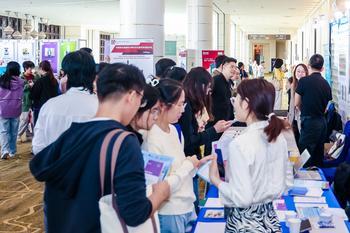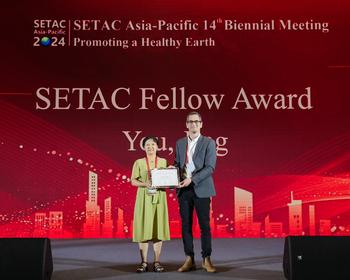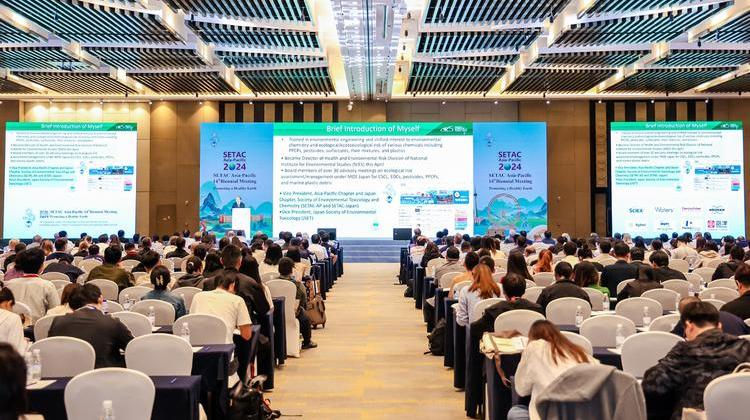Highlights from the SETAC Asia-Pacific 14th Biennial Meeting
Carlos R. Arias Barreiro, SETAC Asia-Pacific President

The SETAC Asia-Pacific 14th Biennial Meeting took place from 21–25 September 2024, in Tianjin, China, co-organized with the College of Environmental Science and Engineering of Nankai University (CESENU). This marked the second SETAC Asia-Pacific event held in China since 2010, chosen to acknowledge SETAC’s appreciation for its Chinese members and the significant volume of research originating from the region.
Under the theme “Promoting a Healthy Earth,” the event highlighted international experts in ecotoxicology, environmental chemistry, environmental health, emerging contaminants and more, addressing the challenges between humans and our evolving environment. The conference served as a platform for scientists, researchers, policy makers, industry professionals, young students and environmental enthusiasts to discuss environmental issues in the Asia-Pacific region and globally; promote cooperation; exchange knowledge, ideas and solutions; and inspire collective action.
A record-breaking 1,255 delegates attended the meeting, primarily from China along with representatives from 28 countries. The event featured a total of 752 presenters, including 554 oral presentations and 194 poster presentations.
The success of the meeting would not have been possible had it not been for the indefatigable behind-the-scenes work of CESENU’s Dean, Professor Lingyan Zhu, Professor (and former Dean) Hongwen Sun, and Assistant Professor Yiming Yao. To maximize the number of participants, other scientific societies, such as the American Chemical Society (USA) and the Royal Society of Chemistry (UK), were invited to participate in special sessions.

Recognizing Outstanding Contributions: Awards Presented at the Meeting
At the meeting, SETAC presented several awards, including the prestigious SETAC Fellows Award, which was given to Jing You from Jinan University in Guangzhou, China. The event also recognized the Best Student Presentation Award winners, celebrating the achievements of emerging researchers. You can view the full list of winners here.
Inspiring Insights: Key Takeaways from Our Plenary Speakers
The SETAC Asia-Pacific meeting featured an impressive lineup of plenary speakers, each bringing unique insights on critical topics. Here’s a look at the speakers and their presentations:
Guibin Jian, member of the Chinese Academy of Sciences from the Research Center for Eco-Environmental Sciences, opened the conference with his talk, “Identification and toxicological understanding of new pollutants: A case study of tetrabromobisphenol A compounds.” He noted that the China Association for Science and Technology has twice selected new and emerging pollutants among the annual top 10 most important scientific issues and that the current challenges lie in identifying, tracing and controlling the health risks of new pollutants in multimedia environments. As such, he provided a historical and prospective assessment of the work by his team on how to identify new pollutants, such as TBBPA (tetrabromobisphenol A). He stated that, despite the availability of in vitro assays, such as AhR (aryl hydrocarbon receptor) and PPARγ (peroxisome proliferator-activated receptor gamma), known chemical contaminants typically explain only a limited proportion of the effects observed in real samples for many toxicity endpoints. He added that machine learning and in silico methods are gradually becoming more integrated into traditional mass spectrometric non-target screening and effect-directed analysis workflows.
Hiroshi Yamamoto, the current SETAC Asia-Pacific Vice President, from the National Institute for Environmental Studies of Japan, presented “Asia-Pacific perspectives on ecological risk assessment and management of chemicals and mixtures.” He discussed the wide array of work done by his team, including work on the adoption and revision of ecotoxicity Organisation for Economic Co-operation and Development (OECD) testing methodologies, the safety of biodegradable plastics, sediment toxicity for benthic organisms, and others. He argued that because of rapid economic growth, the research capability in the most populated countries in Asia, i.e., China and India, is also growing with the consistent contribution by OECD countries in the region, i.e., Australia, Japan and South Korea. He recommended including more editors and editorial board members from the region in the SETAC journals, considering the substantial number of publications and editors from China in other environmental science journals. Discussing the varying geographical, historical and cultural backgrounds, he made a case to consider the different chemical pollution issues as well as the chemical regulatory frameworks in place in the region.

Beate Escher from the Helmholtz Centre for Environmental Research – UFZ in Germany presented “Learning from environmental chemistry: A mechanism-based approach to toxicology and chemical risk assessment.” She suggested that, for effective hazard assessments, environmental risk assessments and biomonitoring, more chemistry should be imbued in toxicology assessments to better understand exposure in modern in vitro cell-based bioassays and to perform quantitative in vitro to in vivo extrapolations (QIVIVE). She argued that specific steps to achieve this would include modeling and measuring exposure and freely dissolved concentrations, as well as considering the speciation of acids, bases and multiprotic chemicals. She also presented results of the PANORAMIX Project, which aims to advance the risk assessment of chemical mixtures through the application of in vitro bioassays for environmental biomonitoring.
SETAC Fellow Jennifer Stauber from Latrobe University, Australia, presented “Addressing the triple planetary crisis: Incorporating climate change into environmental risk assessment.” Considering the three crises – climate change; pollution, chemicals and waste; and biodiversity loss – she explained the degree of interconnection between these and used the example of Australia’s Great Barrier Reef as a case study for incorporating climate information in an environmental risk assessment. In relation to the reef and based on the assessment, the biggest risk is climate change, which is exacerbated by poor water quality, which reduces reef resilience and recovery. The projected risks are supported by long-term monitoring. The largest sources of uncertainty lie in global climate models as there are a wide range of emission scenarios and possible future climate outcomes. Stauber stated that dealing with the triple crises should be done at the international level (a globally agreed, coordinated and funded approach; strong evidence-based science; etc.), national level (political resolve, government legislation and funding support) and local level (societal engagement, activism and individual actions).
Yongguan Zhu, a member of the Chinese Academy of Sciences and the Research Center for Eco-Environmental Sciences, presented “Plastisphere in One Health.” He discussed the ubiquity and continuous accumulation of microplastics in global ecosystems. Due to the growth of the plastisphere, global microbial niches are expanding, and there is an impact in biogeochemical cycling, e.g., N and C, profoundly affecting the earth’s ecosystems. As a result, he argued that the aquatic plastisphere is a potential hotspot for antibiotic-resistant genes, pathogens and viruses, posing ecological and health risks through processes of “rafting” and “refuge.”
Sebastian Böcker from the Friedrich Schiller University Jena in Germany presented “Turning tandem mass spectra into metabolite structure information: What is new in SIRIUS 6?” He discussed the latest updates to SIRIUS, a software for discovering a landscape of de-novo identification of metabolites using tandem mass spectrometry. Within the field of bioinformatics, he extolled the benefits of COSMIC, a workflow that allows the user to assign confidence to structure annotations, for every structure annotated by CSI:FingerID, which predicts a molecular fingerprint that encodes the structure of the query compound, then uses this to search a molecular structure database such as PubChem. You can find more information about his work at youtube.com/@boeckerlab.
Edward Topp from the University of Burgundy, France, presented “Fate and impacts of antibiotics in agricultural soils.” He discussed accelerated biodegradation and metabolism of macrolide antibiotics. As a worrying trend, he mentioned that antibiotic resistance genes that confer resistant to multiple classes of antibiotics have become more abundant, just as multiple mobile genetic elements. He added that there are genes in soil conferring resistance to macrolide antibiotics through unknown mechanisms.
Hongwen Sun from Nankai University, China, presented “Occurrence and transformation of PFAS in the environment.” Using examples from various industries and environmental media in China, she discussed the significant data gaps in understanding per- and polyfluoroalkyl substances (PFAS) transformation mechanisms, primarily due to their everchanging and widespread uses. As a result, she argued, target analysis based on limited standards often overlook more than 50% of the associated risk. She further noted that PFAS precursors are likely to degrade into persistent PFAAs (perfluoroalkyl acids). She also highlighted the specific case and relevance of observed elevated levels of PFAAs, especially TFA (trifluoroacetate) in seashore environments in China.
Special thanks go to all sponsors and the volunteer students from Nankai University, who helped with the day-to-day venue management onsite.
The SETAC Asia-Pacific 15th Biennial Meeting will be held in 2026 in Japan, with exact dates and host city to be announced in the upcoming year.
Author’s contact: https://www.linkedin.com/in/carlos-r-arias-barreiro-b129a36/